Comet Nishimura arrives for binoculars and telescopes. Comet Nishimura, discovered just last month, is brightening in the morning sky but also getting lower toward the pre-dawn horizon. You'll need an open view very low to the east-northeast, assuming you live in the world's mid-northern latitudes. The farther north you are the better. Its tail points up.
Next week Nishimura will lurk similarly low during evening twilight in the west-northwest to west. It will reach perihelion on September 17th, which is also its predicted time of greatest brightness — possibly 2nd magnitude not counting the effects of bright twilight and atmospheric extinction so low. Given those factors, will it ever be even slightly visible to the naked eye? Time will tell. See Bob King's New Comet Nishimura article for more information and finder charts.
After perihelion, Comet Nishimura will sail away low in evening twilight for the Southern Hemisphere.
FRIDAY, SEPTEMBER 1
■ Just after twilight fades away, look for bright Vega passing near the zenith (if you live in the world's mid-northern latitudes). Vega goes right through your zenith if you're at latitude 39° north: near Baltimore, Kansas City, Lake Tahoe, Sendai, Beijing, Athens, Lisbon.
■ As dawn brightens, catch Venus low in the east coming out of inferior conjunction with the Sun. In a telescope or even good binoculars it's a thin crescent, just 11% sunlit.
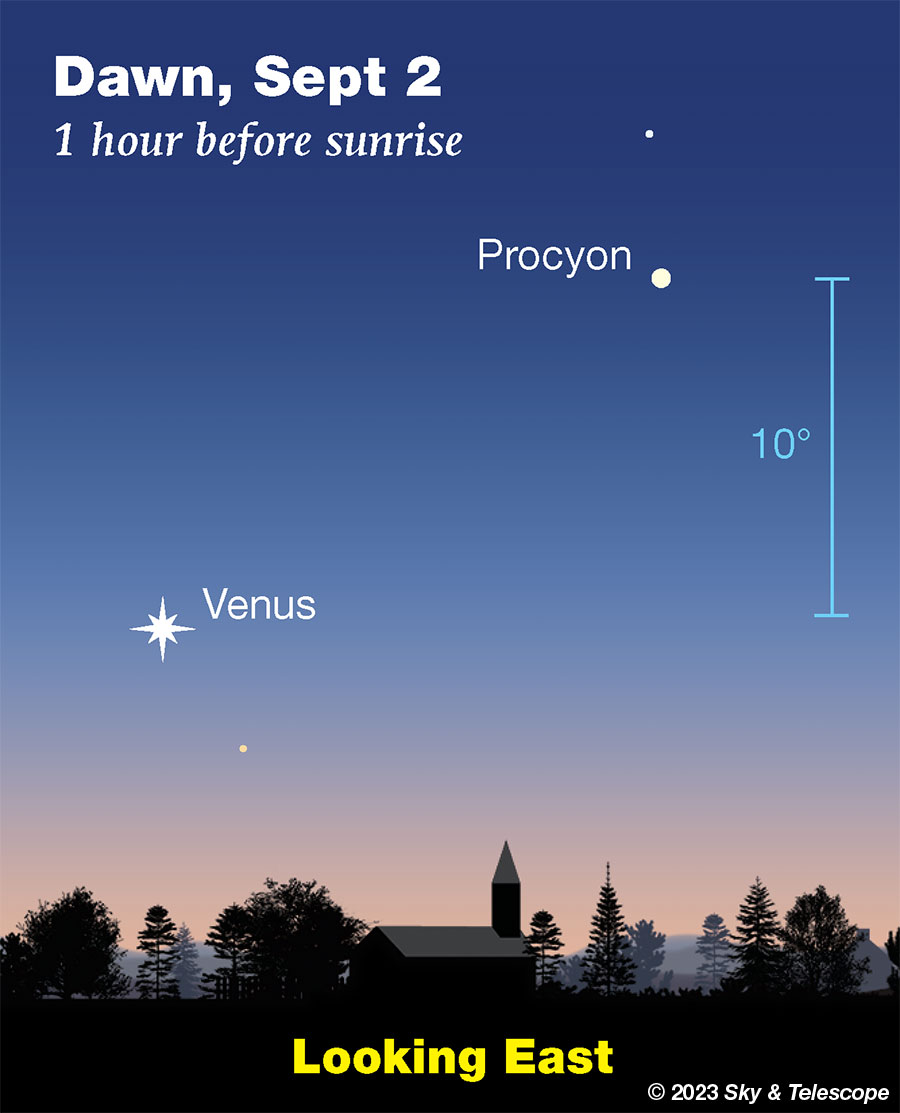
SATURDAY, SEPTEMBER 2
■ The two brightest stars of September evenings are Vega high overhead and Arcturus in the west, both magnitude 0.
Draw a line from Vega down to Arcturus. A third of the way down you cross the dim Keystone of Hercules. Two thirds of the way you cross the dim semicircle of Corona Borealis displaying its one modestly bright star: Alphecca, the gem of the crown.
SUNDAY, SEPTEMBER 3
■ A late-night telescope session tonight offers the Moon in its interesting waning gibbous phase. Lunar landforms near the terminator cast their shadows in the opposite direction from when you see the Moon as a thick waxing crescent in early evening.
Then switch to Jupiter shining right nearby, as shown below. Jupiter's four bright Galilean moons are roughly the size of our own Moon, but at 1,800 times the distance, they appear in a telescope as hardly more than pinpoints.
Jupiter's Great Red Spot should transit the planet's central meridian tonight around 1 a.m. EDT.
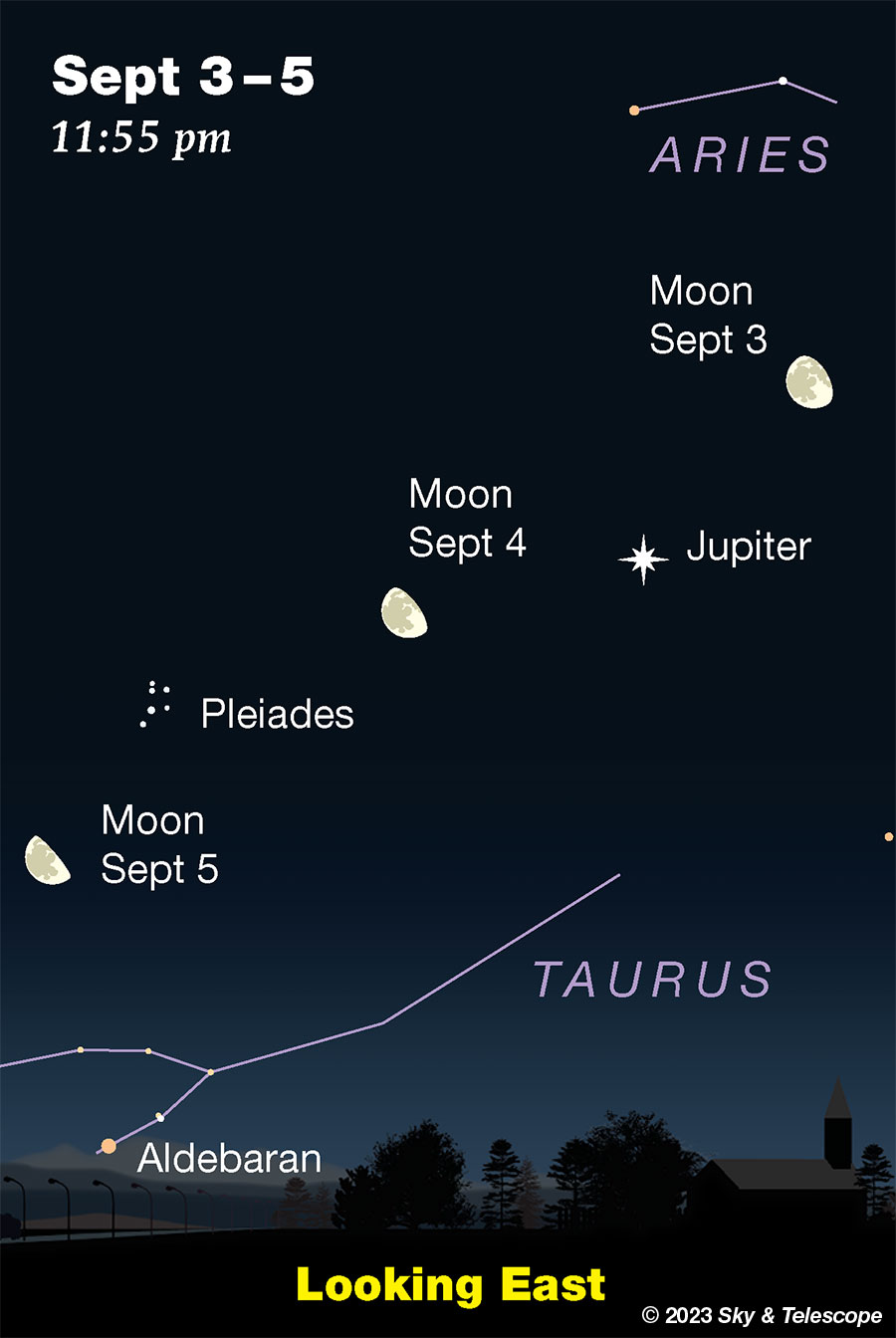
MONDAY, SEPTEMBER 4
■ The waning gibbous Moon rises around 10 p.m. with Jupiter 6° or 7° to its right. They cross the sky together for the rest of the night.
TUESDAY, SEPTEMBER 5
■ As dusk turns to night, Arcturus twinkles due west. It's getting lower every week. Off to its right in the northwest, the Big Dipper is swinging down on its way to turning level.
WEDNESDAY, SEPTEMBER 6
■ Vega now passes the zenith right around the end of twilight, for those of us at mid-northern latitudes. Vega is bigger, hotter, and 50 times brighter than our Sun. But at a distance of 25 light-years, it's 1.6 million times farther away. We're lucky that our eyes can see such things at all. As they evolved, they had no need to.
■ Last-quarter Moon (exactly so at 6:21 p.m. EDT). It rises around 11 or midnight tonight, in eastern Taurus.
Once it's well up, look for El Nath (Beta Tauri) about 5° to its left or lower left. Brighter Aldebaran is some 10° to the Moon's right.
THURSDAY, SEPTEMBER 7
■ In the barren region midway between the handle of the Sagittarius Teapot and the bottom of boat-shaped Capricornus lies an asterism of four stars all by itself. In ancient times Ptolemy cataloged it as the Tetrapleuron, the Quadrilateral. Being so isolated, it was not incorporated into the star pattern of either constellation. Nowadays the group is sometimes known as The Dogs (from a local tradition in southern China of monsterous dog-people in the mountains) or, more recently, as Herman's Cross, named for the late Maryland amateur astronomer Herman Heyn who rediscovered it and publicized it.
Herman's Cross is now highest on the meridian in mid-evening. It lies more or less on its side and is about 1° by 2° in size. Its stars are all about magnitude 4½, making it a fine binocular target and visible to the naked eye in a moderately dark sky. It's such a distinctive little thing that once you know it you'll spot it often in photos of the Sagittarius Milky Way, demurely off to the east of the main attraction.
Two telescopic globular clusters, M75 and M55, lie a few degrees above and below it. They're 9th and 7th magnitude, respectively. See Matt Wedel's Binocular Highlights article and chart in the September Sky & Telescope, page 45.
FRIDAY, SEPTEMBER 8
■ With September well under way, the Great Square of Pegasus is high in the east after dark, balancing on one corner.
From the Great Square's left corner extends a big line of three 2nd-magnitude stars, running to the lower left, that mark the head, backbone and leg of the constellation Andromeda. (The line of three includes the Square's corner, her head.) Upper left from the foot of this line, you'll find W-shaped Cassiopeia tilting up.
■ By 9 or 10 p.m. two of the best-known deep-sky objects are in high view in the area: the Double Cluster in Perseus (just below Cassiopeia), and the Great Andromeda Galaxy, M31. Did you know they're only 22° apart?
They're both cataloged as 4th magnitude but to the naked eye they look rather different, the more so the darker your sky. See for yourself; they're plotted on the all-sky constellation map in the center of the September Sky & Telescope, which should be all the map you need to identify their locations. They're below Cassiopeia and farther to Cassiopeia's right, respectively. Sky too bright? Use binoculars!
The two clusters of the Double Cluster (NGC 869 and NGC 884) are at very similar distances about 7,600 light-years away. M31, at 2.5 million light-years, is about 330 times farther.
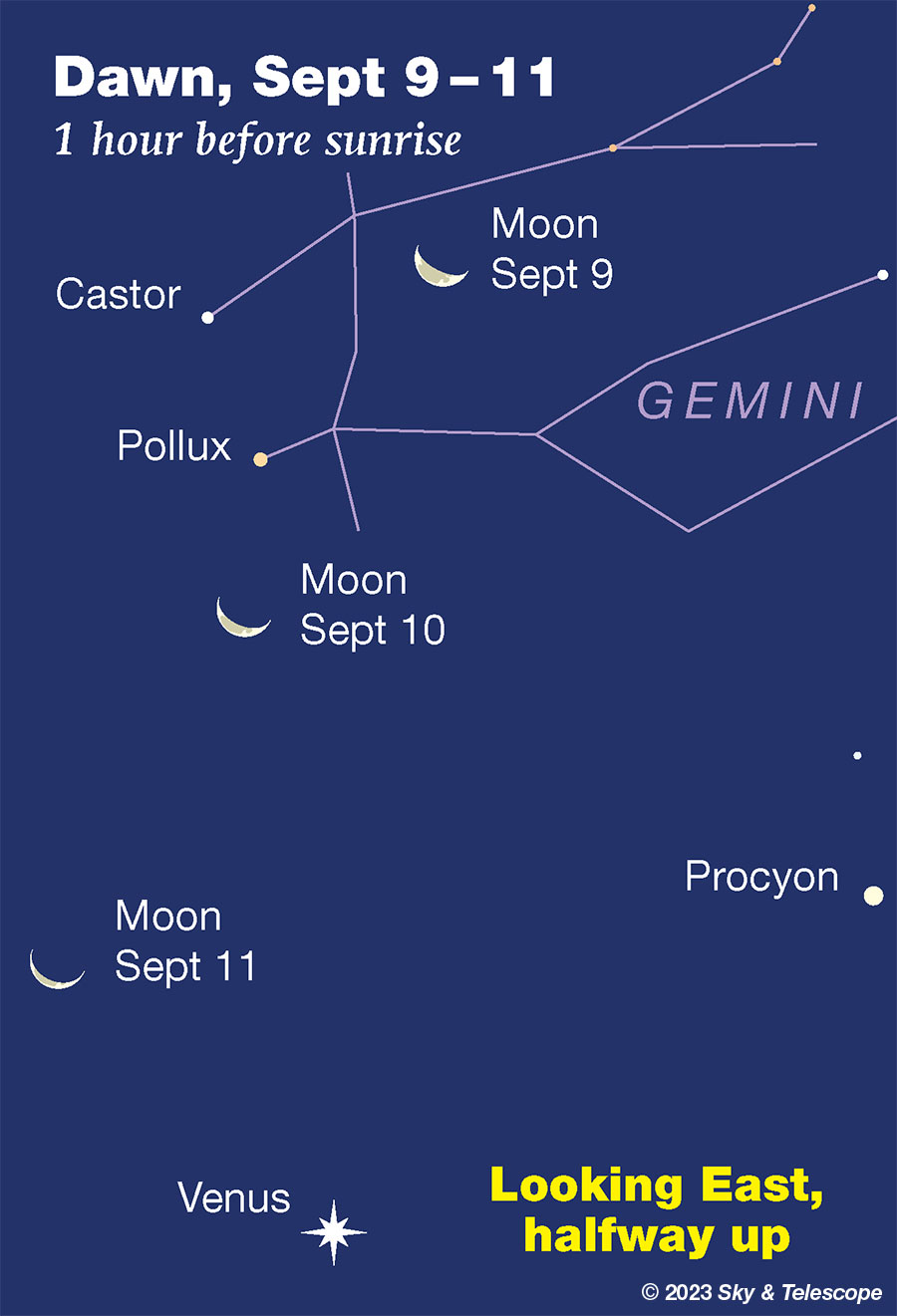
SATURDAY, SEPTEMBER 9
■ The waning crescent Moon rises around 3 a.m. Sunday morning the 10th, under Castor and Pollux. By early dawn they're a vertical lineup high in the east as shown above.
SUNDAY, SEPTEMBER 10
■ With the evening sky moonless, this is a great week for the Milky Way under a dark sky. When Deneb crosses your zenith (two hours after Vega does, meaning around 10 or 11 p.m.), the Milky Way does too — running straight up from your southwest horizon and straight down to your northeast horizon.
This Week's Planet Roundup
Mercury and Mars are out of sight in the glare of the Sun.
Venus (magnitude –4.6) is emerging low in the dawn. Look for it due east. It gets higher and easier every day. Even low magnification shows that Venus is a thin crescent. The crescent will get thicker and smaller in the coming weeks as it climbs higher in the dawn, the reverse of how it grew thinner and larger while heading down into the sunset in June and July.
Jupiter (magnitude –2.6, in Aries) rises about an hour after dark. Watch for it to come up low in the east-northeast. It shines highest in the hours before dawn.
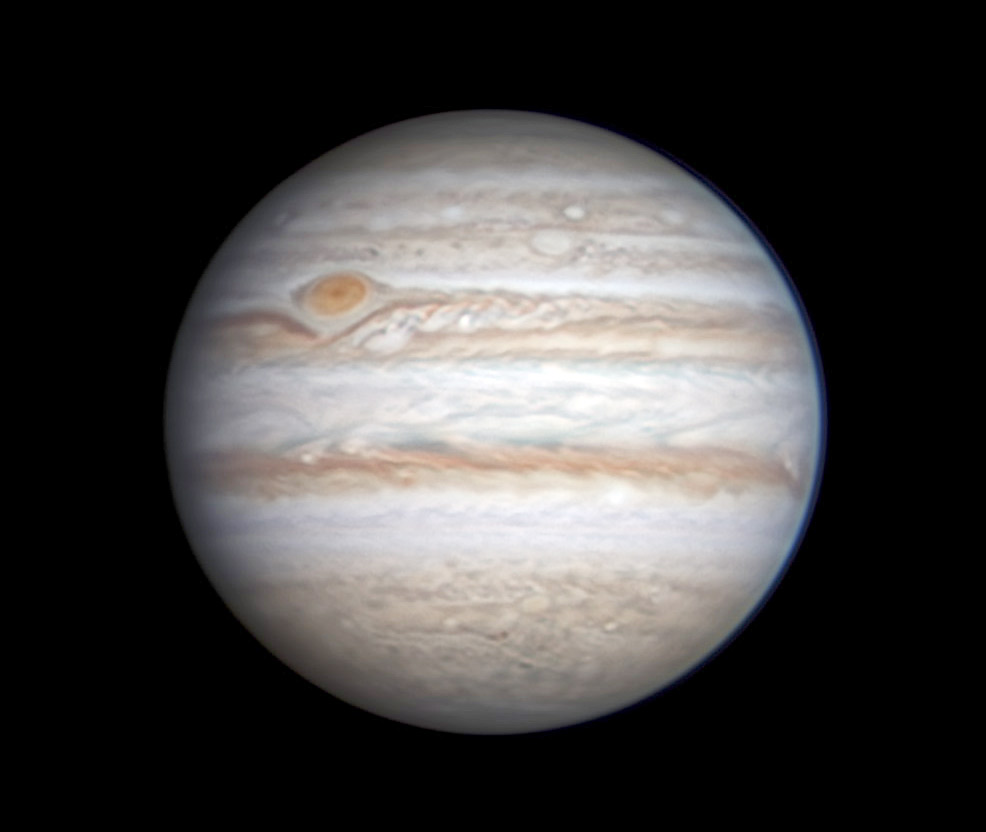
Saturn (magnitude +0.4, in dim Aquarius) is the "star" low in the southeast in twilight. It was at opposition last week. It's at a good height for telescopic observing by 11 p.m., by which time Fomalhaut is twinkling two fists below it. Saturn is highest in the south around midnight.
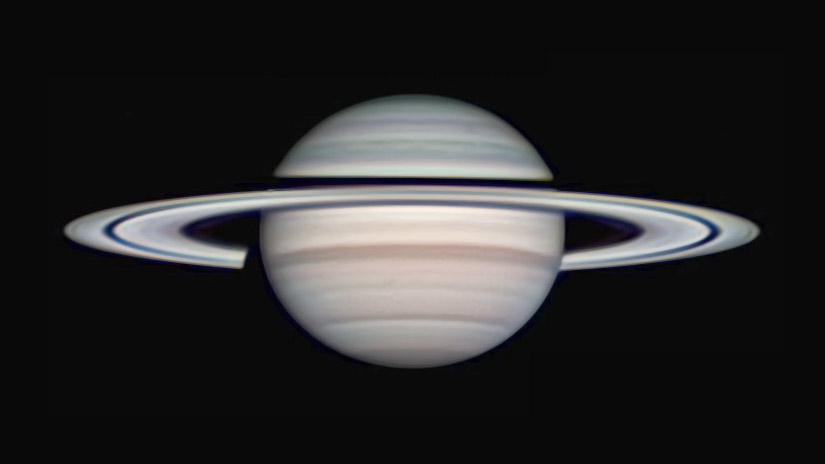
Currently Saturn is close to opposition, so the shadow of the globe on the rings behind (the black gap at the lower left here) has disappeared from view.
Uranus, magnitude 5.7 in Aries, is nice and high in the hours before dawn, 7° or 8° east of Jupiter.
Neptune, magnitude 7.8 at the Aquarius-Pisces border, is fairly high by 10 or 11 p.m., 23° east of Saturn.
All descriptions that relate to your horizon — including the words up, down, right, and left — are written for the world's mid-northern latitudes. Descriptions and graphics that also depend on longitude (mainly Moon positions) are for North America.
Eastern Daylight Time (EDT) is Universal Time minus 4 hours. UT is sometimes called UTC, GMT, or Z time.
Want to become a better astronomer? Learn your way around the constellations. They're the key to locating everything fainter and deeper to hunt with binoculars or a telescope.
This is an outdoor nature hobby. For a more detailed constellation guide covering the whole evening sky, use the big monthly map in the center of each issue of Sky & Telescope, the essential magazine of astronomy.
Once you get a telescope, to put it to good use you'll need a much more detailed, large-scale sky atlas (set of charts). The basic standard is the Pocket Sky Atlas (in either the original or Jumbo Edition), which shows all stars to magnitude 7.6.

Next up is the larger and deeper Sky Atlas 2000.0, plotting stars to magnitude 8.5; nearly three times as many. The next up, once you know your way around, are the even larger Interstellarum atlas (stars to magnitude 9.5) or Uranometria 2000.0 (stars to mag 9.75). And be sure to read How to Use a Star Chart with a Telescope. It applies just as much to charts on your phone or tablet as to charts on paper.
You'll also want a good deep-sky guidebook. A beloved old classic is the three-volume Burnham's Celestial Handbook. An impressive more modern one is the big Night Sky Observer's Guide set (2+ volumes) by Kepple and Sanner.
Do computerized telescopes replace charts? Not for beginners I don't think, especially not on mounts and tripods that are less than top-quality mechanically. Unless you really prefer spending your time getting finicky technology to work rather than getting to know the sky. As Terence Dickinson and Alan Dyer say in their Backyard Astronomer's Guide, "A full appreciation of the universe cannot come without developing the skills to find things in the sky and understanding how the sky works. This knowledge comes only by spending time under the stars with star maps in hand."
But finding very faint objects the old-fashioned way with charts isn't simple either. See How to Use a Star Chart with a Telescope to learn the tricks.
![]() Audio sky tour. Out under the evening sky with your
Audio sky tour. Out under the evening sky with your
earbuds in place, listen to Kelly Beatty's monthly
podcast tour of the naked-eye heavens above. It's free.
"The dangers of not thinking clearly are much greater now than ever before. It's not that there's something new in our way of thinking, it's that credulous and confused thinking can be much more lethal in ways it was never before."
— Carl Sagan, 1996
"Facts are stubborn things."
— John Adams, 1770
 14
14









Comments
Rod
September 1, 2023 at 6:28 am
I was able to enjoy some time under the stars last night, lovely sky. Observed 2000-2200 EDT. Full Moon 30-August-2023. August 2023 issue of Sky & Telescope shows Full Moon 31-August-2023 0136 UT/2136 EDT 30-August-2023 so waning gibbous tonight in Aquarius. Moon rise near 2021 EDT. As the Moon rose higher, the fields lit up with moonlight. The Moon hit me in the eye like a big pizza pie, its amore The Moon and Saturn separated by a bit more than 19.5 degrees according to Stellarium 23.2. I enjoyed views of Saturn ranging 31x to 111x views using TeleVue eyepieces with my 90-mm refractor telescope. The moons Titan and Rhea were distinct in the north up and mirror reverse view. Skies clear, temperature 17C, winds 360/7 knots, h=62%. It was a relaxing evening out and I could see three or four satellites in the early period pass by, most were polar orbiting near 2nd magnitude. Saturn rose above a tree line near 2100 EDT, an easy target to view. Saturn provided more detail at 71x and 111x using TeleVue 14-mm Delos and TeleVue 9-mm Nagler. Hint of Cassini division along with some cloud banding. The rings are closing. Before viewing Saturn, I enjoyed some low power views of Arcturus at 31x and unaided eye views of the summer triangle (Deneb, Vega, and Altair regions).
Here is a bonus feature, the Pentagon stood up an official website for reporting UFO/UAPs 🙂 https://www.aaro.mil/
Nothing for me to report. Looks like Fed employees and military can presently report. My stargazing log reaching back more than 30 years shows nada here for ET buzzing me 🙂
You must be logged in to post a comment.
Anthony Barreiro
September 1, 2023 at 7:23 pm
I disagree with the assertion that our ancestors had no need to be able to see the stars. Our relationship to the larger is cosmos is an essential aspect of what makes us sentient beings. Perceiving and understanding the cosmos has been essential on every level from the practical -- keeping track of time and the seasons, finding our way on the surface of the Earth -- to our religious, spiritual, philosophical and scientific dimensions. Our capacity to experience awe and wonder would be greatly impoverished if we could only see what is in front of our noses.
You must be logged in to post a comment.
TomR
September 4, 2023 at 10:58 am
Beautifully expressed!
You must be logged in to post a comment.
Alan MacRobertPost Author
September 5, 2023 at 2:25 pm
Yes, those things have been important to the development of humanity as we know it today. But the ability to see faint things in the night sky is a lucky side effect of how our eyes evolved -- they did not shape the eye's evolution. Many animals have eyes that are as good or better than ours at night -- without the philosophical and spiritual benefits of the stars shaping how their eyes evolved to be that sensitive. Deep-sea squids evolved better, more sensitive eyes than ours and they never see anything above the ocean depths at all!
You must be logged in to post a comment.
Rod
September 6, 2023 at 7:50 am
Interesting answer on how our eyes evolved to see the starry heavens 🙂 It seems such a model predicts our eyes would evolve also to see various starry objects if we lived on a red dwarf star like TRAPPIST-1 system, perhaps we would see the red stars much better. In the fossil record we have trilobites with complex eyes and many missing transitional eyes not found until ours appear that can see the stars living on land. There is that abominable problem of the plants too that gets in the way here.
You must be logged in to post a comment.
Rod
September 3, 2023 at 6:16 am
The early morning sky at my location this morning, quite lovely. Venus bright in Cancer, Jupiter up in Aries, and the waning gibbous Moon in Pisces. I got my leaf blower ready for the season yesterday 🙂
You must be logged in to post a comment.
mary beth
September 4, 2023 at 3:44 pm
Hi Rod so glad you are able to enjoy the night skies again. We are loving Saturn and Fomalhaut. Arcturus is a delight as well and we are still blessed with Scorpius all evening too.
Sadly, the severe drought is causing all the trees to lose their leaves so we may not have any autumn color this year. We have very little anyway….hope you have color.
Still swimming?
You must be logged in to post a comment.
Rod
September 4, 2023 at 6:28 pm
Yes, I am 🙂 Closed out the pool season (outdoor) yesterday and today at my grandchildren pool, lap swimming and playing great white shark or perhaps, manatee. 🙂 Wonderful way to close the summer and swimming pool times.
You must be logged in to post a comment.
1234Shepherd5678
September 4, 2023 at 2:21 pm
Seems to me that all your observations are sights looking east with no comparable views looking west. Is that due to the subjects YOU are interested in or is it a fact that looking West is dull. Being one living in a condo with a west view only, I'm trying to find targets that appear in the western sky, if not every night at least some now and then.
You must be logged in to post a comment.
Rod
September 5, 2023 at 10:41 am
For my location, east, south sky has much less light pollution living in an open space and more rural area with small farms. West and NW views more light pollution (looking towards VA and DC). Finding targets is easy if you use the monthly Sky & Telescope magazine charts or software like Stellarium. The weekly updates at this site also are very useful.
You must be logged in to post a comment.
mary beth
September 5, 2023 at 11:16 am
Like you my best view is west. Arcturus is a beautiful bright star that is now in the west/northwest in the evenings. It will hang around through October. In mid to late spring, Orion and quite a few other stars, constellations and asterisms are visible all evening….quite a sight! And of course the waxing crescent moon is usually visible there for about a week. You can look at the archived columns for May to get an idea about what you’ll see in Springtime. At least you and I can see the beautiful glow of sunset! Hope you see Arcturus tonight! Eventually Vega, which is overhead in the evenings now, and the entire Summer Triangle will be heading west for later in autumn! Best wishes for clear starry skies!
You must be logged in to post a comment.
Alan MacRobertPost Author
September 5, 2023 at 2:15 pm
Sky at a Glance tends to follow the Moon and planets preferentially because they change a lot, and they're equally morning as evening in the long run.
But you can always use our Interactive Sky Chart https://skyandtelescope.org/observing/interactive-sky-chart/
to plan star and constellation spotting in any direction at any time of night!
You must be logged in to post a comment.
mary beth
September 6, 2023 at 10:56 am
I have been a faithful daily reader of this column for over 20 years. It has taught me so much! You and Monica do a great job. Thank you so much for freely sharing your knowledge!
You must be logged in to post a comment.
Rod
September 6, 2023 at 7:39 am
I did see Nishimura early this morning. Observed 0525-0605 EDT. Sunrise 0640 EDT. Last Quarter Moon 06-Sep-2022 1821 UT. Come C/2023 P1 visible in my 10x50 binocular view as a faint fuzzy with some cirrus that times, obscured the view. The comet close to 1.5-degrees from epsilon Leo, Ras Elased Australis or Algenubi. I could also see Jupiter with Galilean moons in my binocular view and the nearly Last Quarter Moon, up high, bright, and many craters visible along the terminator line. Venus brilliant to the right in Cancer, some 17.5 degrees from the comet. Early morning ground fog over the fields. Skies mostly clear, some cirrus. Temperature 20C, winds calm, and humidity = 99%. Theskylive.com reported apparent magnitude this morning 4.9 for this comet.
You must be logged in to post a comment.
You must be logged in to post a comment.